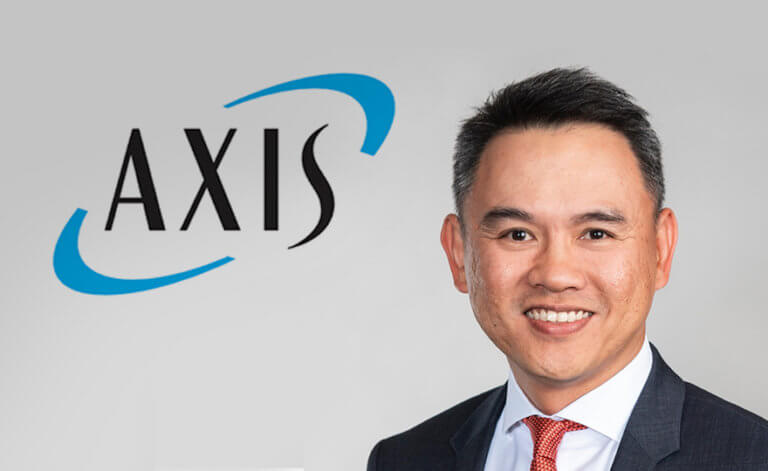Axis Re’s Les Loh talks capacity and shifting risks
November 25 2021 by InsuranceAsia News
InsuranceAsia News (IAN) recently caught up with Les Loh, president — Asia Pacific at Axis Re.
We learned Singapore-based Loh’s views on the upcoming specialty renewal season, market capacity, terms and conditions, retaining and attracting talent as well as the opportunities and risks for Asia’s reinsurers.
IAN: How is the 1.1 2022 P&C specialty Asia Pacific renewal season shaping up?
Loh: There are three points to consider here: capacity, program structure and pricing. We operate in an inter-connected world, what happens in other markets has a direct impact on how APAC shapes up. The region has also seen its fair share of cat losses in the past few years. While the market is diverse and capacity remains ample. However, capacity has become more selective with increased uncertainties around climate change, low interest rate, social inflation and more.
Having the appropriate program structure in place will be a key discussion topic leading up to renewals. Pricing will likely be heavily influenced by the global and local cat activities we have seen, such as the flood losses in China, where we will need more premium in the system to take on the uncertainties. Taking all these onboard, we are seeing submissions coming in earlier in anticipation of a longer negotiation.
IAN: What are some of key changes Axis is making to its approach to reinsurance in Asia Pacific?
Loh: As the market evolves and new risks emerge, we will need to evaluate new views of risks. Whilst it remains important to evaluate the market issues of the past cycle, this must be combined with a new understanding of the emerging risks we are facing going forward. As such, we will continue to fine tune our pricing tool and our approach to both existing and emerging exposures. In addition, we intend to selectively strengthen terms and conditions and engage with the client and the market to shape the right structure for future sustainability.
IAN: What risks and opportunities do you see in the Asia Pacific market today?
Loh: One of the biggest risks we face in the P&C market is climate change. We’ve seen an increase in the frequency and severity of climate-related losses, such as the recent floods in Henan, China, the 2018-19 typhoons in Japan and the bushfires in Australia. Cyber is also a growing threat globally. The move to remote working has changed the dynamic and threat level of cyber risk.
The risk of underinsurance is still very relevant in Asia Pacific, with the rate of insurance penetration remaining low in this part of the world. Insurance plays a critical role in any economy’s development and without getting the right coverage to the people on the ground, the industry will struggle to move in the right direction.
However, with risk comes opportunity. Our focus is on growing with a selective approach, and we’re looking at opportunities in areas like A&H.
IAN: As an industry, what more can we do to attract and retain talent?
Loh: Recruitment is vital. This includes going to universities to make sure young people are aware of the various attractive career opportunities offered within insurance. We need to continue to provide internships and work-experience opportunities, ensuring that interns get the full value of working within our organisations. There must also be an opportunity for interns and young talent to obtain full-time jobs and to develop their careers within the industry.
In addition, having a diverse culture is necessary to attract and retain talent. It is vital to champion equal opportunity for new hires and internal promotions. A team-based management approach allows employees to be recognised by those who work closest with them.
Company culture and flexibility has become indispensable in recent months. We must trust employees to perform to their fullest potential and efficiency in whichever space of work they choose to operate in, whether remotely or at the office, while also supporting them by giving them the tools they need to succeed.
IAN: What have been some of the key lessons for the P&C reinsurance market in Asia Pacific over the last 18 months?
Loh: The past 18 months have mostly been dominated by Covid-19 but the industry has been resilient despite the unprecedented disruption.
In the virtual environment, staying connected becomes ever more important as we are missing the vital face-to-face connection that has been so critical to the industry. This is a people business, built on interaction, so we’ve had to learn how to navigate the challenges we’ve faced in a more virtual way.
A well-connected team, with a strong sense of community, a good work-life balance and a philanthropic culture has allowed Axis and its employees to thrive in a virtual setting.
Market discipline continues to be important in ensuring that our industry strives to be sustainable in the long run. This relates to pricing as well as terms and conditions. We should maintain discipline rather than reacting post-loss which might be too late. It is imperative to be clear with coverages and wordings.
-
QBE | Elevating customer experience, humanising claims: QBE Asia’s ‘Solutions in a Box’
Vastly improving turnaround times and personalising service delivery, QBE Asia’s award-winning, end-to-end bundled claims solutions is a game-changer for the insurance industry.
-
Beazley | What does cyber protection look like from day 1 to day 600 and beyond?
Cybersecurity is no longer just an IT concern, but a governance issue that belongs on the boardroom agenda.
-
Sedgwick | Preparing for the next storm
Insurance industry needs to recalibrate, invest in innovation and strengthen systems, talent and data practices.
-
Peak Re | From climate modelling to market opportunity: Forging a new clarity on Southeast Asia’s climate risk
Southeast Asia's protection gap: a crisis of clarity, not just capital

